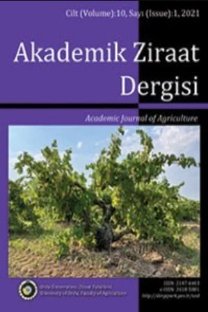Kadife çiçeği (Tagetes erecta L.)'nin Tetranychus urticae Koch. (Acari: Tetranychidae)'ye karşı tuzak bitki olarak kullanımı
Using of marigold (Tagetes erecta L.) as trap plant against Tetranychus urticae Koch. (Acari: Tetranychidae)
___
- Amarawardana L, Bandara P, Kumar V, Pettersson J, Ninkovic V and Glinwood R., 2007. Olfactory response of Myzus persicae (Homoptera: aphididae) to volatiles from leek and chives- potential for intercropping with sweet pepper. Acta Agriculturæ Scandinavica B ;57: 87-91.
- Anonim, 2008. Zirai Mücadele Teknik Talimatları, Sebze zararlıları, Cilt 3. Ankara.
- Anonymous, 2016. How to Plant Marigolds to Protect Tomatoes. http://homeguides.sfgate.com/plantmarigolds-protect-tomatoes-35602.html. (Erişim tarihi:26.10.2016).
- Baytop, A. 1998. Botanik kılavuzu., İstanbul Üniv. Eczacılık Fakültesi, 241s.
- County, C. 1999. Companion Planting. Cornell Cooperative Extension. NYS College of Agriculture and Life Sciences at Cornell University. Department of Agriculture, Cooperating.
- Dabrowski, Z., Seredynska, U. 2007. Characterisation of the two-spotted spider mite (Tetranychusurticae Koch, Acari: Tetranychidae) response to aqueous extracts from selected plant species. Journal of Plant Protection Research; 47: 113-124.
- Fattah, Q. A., 2005. Plant Resources for human development nitrogen rice. Third International Botanical Conference. 9-11 December, Dhakai.
- Finch, S., Collier, R. H., 2000. Host-plant selection by insects - a theory based on 'appropriate/ inappropriate landings' by pest insects of cruciferous plants. Entomologia Experimentalis 96: 91-102.
- Finch, S, Billiald, H.,Collier, RH., 2003. Companion planting-do aromatic plants disrupt host-plant finding by the cabbage root fly and the onion fly more effectively than non-aromatic plants, Entomologia Experimentalis et Applicata 109: 183- 195.
- Glenister, C., Newman, S., Sandsted, M.,2014. Live Thrips Traps: Using Inexpensive Marigolds to Draw Thrips Away from Greehouse Crops. SARE: Sustainable Agriculture Research and Education. Universty of Maryland, Department of Agriculture.
- Gill, D., 2008. The thruth about marigolds. http://blog.nola.com/dangill/the_trouth_about _marigolds.html. (Erişim tarihi: 30.12.2016).
- Hussain, B., Bilal, S.,2007. Marigold as a Trap Crop Against Tomato Fruit Borer (Lepidoptera:Noctuidae) International Journal of Agricultural Research, 2:185-188.
- Hethelyi, E., Danos, B.,Teteny, P.1986. CG-MS analysis of the essential oils of four Tagetes species and the anti-microbial activity of Tagetes minuta. Flavour and Fragence Journal 1: 169-173.
- Johnson, WT, Lyon, HH., 1991. Insects that Feed on Trees and Shrubs. 2nd ed., rev. Comstock Publishing Associates. 560 p.
- Khan Z R and Pickett J A. 2004. The 'push-pull' strategy for stemborer management: a case study in exploiting biodiversity and chemical ecology. Ecological Engineering for Pest Management-Advances in Habitat Manipulation for Arthropods, CABI, 155- 164.
- Khan, Z. R., Ampong-Nyarko, K., Chilishwa, P., Hassanali, A., Kimani, S., Lwande, W., Overholt, W. A., Pickett, J. A., Smart, L E., Wadhams, L. J., Woodcock, C. M., 1997. Intercropping increases parasitism of pests. Nature, 388: 631-632.
- Krueger, R., Dover, R., McSortey, R., Wang, K.H. 2007.Marigolds (Tagetes spp.) for Nematode Management. http://edis. İfas.uff.edu.(Erişim tarihi: 02.01.2017).
- Landolt, P., Hofstetter, R.W., Biddick, L. L.1999. Plant essential oils as arrestants and repellents for neonate larvae of the coding moth (Lepidoptera: Tortricidae). Enviromental Entomology, 28: 954- 960.
- Luther, G. C, Valenzuela, H R., De Frank, J., 1996. Impact of cruciferous trap crops on Lepidopteran pests of cabbage in Hawaii. Environmental Entomology, 25: 39-47.
- Matsumoto, K., Kotulai, J. R., 2002. Field tests on the effectiveness of Azadirachta companion planting as a shoot borer repellent to protect mahogany. Japan International Research Center for Agricultural Sciences; 10: 1-8.
- MMSU, 2003. 7 new botanical extracts garlic pests. Mariano Marcos State University. Batac Ilocos Norte, Philippines.
- Parker, J. E., Synder, W. E., Hamilton, G. C., Rodriguez, C.S., 2013. Companion planting and insect pest control. Intech. Dx.doi.org/10.5772/55044.
- Pickett, J.A., Wadhams, L.J.,Woodcock, C.M., 1997. Developing sustainable pest control from chemical ecology. Agriculture, Ecosystems and Environment 64: 149-156.
- Pyke, B., Rice, M.J., Sabine, B., Zalucki, M., 1987. The pushpull strategy - behavioural control of Heliothis. Australian Cotton Grower,May-July: 7-9.
- Rust, R. W.,1997. Evaluation of trap crop procedures for control of Mexican bean beetle in soybeans and lima beans. Journal of Economic Entomology, 70: 630-632.
- Scheffler, I., Dombrowski, M.1993. Behavioural responses of Blattella germanica L. (Orthoptera: Blattelidae) induced by repellent plant extracts. Journal of Applied Entomology;115: 499-505.
- Soule,J.1993. Tagetes minuta: A potantial new herb South America.Pp.649-654 in: NEW Crops, Wiley, N.Y.http://www.hort.purdoe.edu/newcrop/procee dings1993/v2-649.html//Botany (Erişim tarihi:. 02.01.2017)
- Stern, V. M. 1981.Environmental control of insects using trap crops, saniation, [prevention and harvesting. in Handbook of Pest Management in Agriculture. D. Pimentel (ed). Vols. 1, 2. Boca Raton, FL.
- Şeniz, V., Özgür, M., Sivritepe, Ö., Özer M., 2014. Sebzecilik, Anadolu Üniversitesi Basımevi, Eskişehir. Thresh, M., 1982. Cropping practices and virus spread. Annual Review of Phytopathology, 20: 193-218.
- Wang,K. H., Cerruti, R. H., Ploeg, A., 2007. Protecting Crops from nematode pests: using marigold as an alternative to chemical nematicides. Cooperative Extension Service. Coliege of Tropical Agriculture and Human Resources. University of Hawai at Monao
- ISSN: 2147-6403
- Yayın Aralığı: 2
- Başlangıç: 2012
- Yayıncı: Ordu Üniversitesi Ziraat Fakültesi
Ertan YILDIRIM, Atilla DURSUN, Melek EKİNCİ, Fazilet KARAGÖZ, Raziye KUL
Farklı dozlarda kükürt uygulamasının turp (Raphanus sativus L.)'ta verim ve kalite üzerine etkileri
İlknur SOLMAZ, Barış DAL, Hikmet ERKÖSE, Furkan AKBAŞ, Nebahat SARI
Karpuzda Fusarium oxysporum f. sp. niveum'a tolerant nitelikli hatların geliştirilmesi
Nedim MUTLU, Hasan PINAR, Nebahat SARI, Mustafa ÜNLÜ, Veysel ARAS, Çetin NACAR, Tahsin AY
